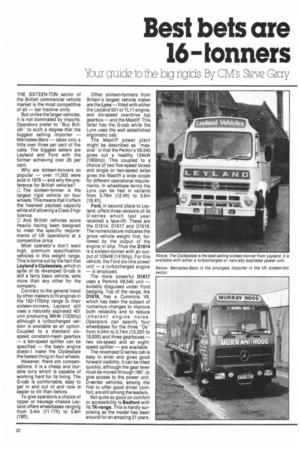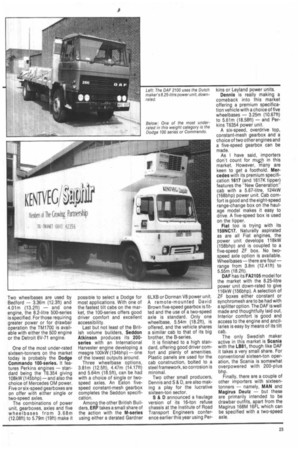Best bets are 16 homers
Page 138

Page 139

If you've noticed an error in this article please click here to report it so we can fix it.
Your quid to tho big rigbs By CV's Stew Gray
THE SIXTEEN-TON sector of the British commercial vehicle market is the most competitive of all — bar tractive units.
But unlike the larger vehicles. it is not dominated by imports. Operators prefer to "Buy Britishto such a degree that the biggest selling importer — Mercedes-Benz — takes only a little over three per cent of the cake. The biggest sellers are Leyland and Ford with the former achieving over 26 per cent.
Why are sixteen-tonners so popular — over 11,000 were sold in 1978 — and why the preference for British vehicles?
Li The sixteen-tonner is the largest rigid vehicle on four wheels. This means that it offers the heaviest payload capacity while still allowing a Class 3 hgv licence.
E And British vehicles score heavily having been designed to meet the specific requirements of UK operations at a competitive price.
Most operator's don't want high, premium specification vehicles in this weight range. This is borne out by the fact that Leyland's Clydesdale, which in spite of its revamped G-cab is still a fairly basic vehicle, sells more than any other for the company.
Contrary to the general trend by other makers to fit engines in the 150-170bhp range to their sixteen-tonners, Leyland still uses a naturally aspirated 401 unit producing 98kW (132bhp) although a turbocharged version is available as an option. Coupled to a standard sixspeed constant-mesh gearbox — a ten-speed splitter can be specified — the basic engine doesn't make the Clydesdale the fastest thing on four wheels.
However, there are compensations. It is a cheap and durable lorry which is capable of working hard for its living. The G-cab is comfortable, easy to get in and out of and now is easier to tilt than before.
To give operators a choice of tipper or haulage chassis Leyland offers wheelbases ranging from 3.4m (11.17ft) to 5.8m (19ft). Other sixteen-tonners from Britain's largest vehicle maker are the Lynx — fitted with either the Leyland 501 or TL11 engine, and six-speed overdrive top gearbox — and the Mastiff. This latter has the G-cab while the Lynx uses the well established ergomatic cab.
The Mastiff power plant might be described as "massivein that the Perkin's V8.540 gives out a healthy 134kW (180bhp). This coupled to a choice of two five-speed boxes and single or two-speed axles gives the Mastiff a wide scope for different operational requirements. In wheelbase terms the Lynx can be had in variants from 3.79m (12.4ft) to 5.6m (18.4ft).
Ford, in second place to Leyland, offers three versions of its D-series which last year received a face-lift. These are the 01614, D1617 and D1618. The nomenclature indicates the gross vehicle weight first, followed by the output of the engine in bhp. Thus the 01614 is a sixteen-tonner with an output of 105kW (141 bhp). For this vehicle, the Ford six-litre power unit — a turbocharged engine — is employed.
The more powerful D1617 uses a Perkins V8.540 unit — suitably disguised under Ford badging. Top of the range, the D1618, has a Cummins V8, which has been the subject of numerous changes to improve both reliability and to reduce inherent engine noise. Operators can specify four wheelbases for the three "Ds" from 4.04m to 5.74m (13.25ft to 18.83ft) and three gearboxes— two six-speed and an eightspeed splitter — are available.
The revamped D-series cab is easy to enter and gives good forward visibility. It can be tilted quickly, although the gear lever must be moved through 180, to give access to the power unit, D-series vehicles, among the first to offer good driver comfort, are still among the leaders.
Not quite so good on comfort or accessibility is Bedford with its TK-range. This is hardly surprising as the model has been around for an amazing 21 years. Two wheelbases are used by Bedford — 3.36m (12.3ft) and 4.01m (13.2ft) — and one engine, the 8.2-litre 500-series is specified. For those requiring greater power or for drawbar operation the TM170C is available with either the 500 engine or the Detroit 6V-71 engine.
One of the most under-rated sixteen-tonners on the market today is probably the Dodge Commando 100-series. It features Perkins engines — standard being the 16.354 giving 108kW (145bhp)— and also the choice of Mercedes OM power. Five or six-speed gearboxes are on offer with either single or two-speed axles.
The combinations of power unit, gearboxes. axles and five wheelbases from 3.68m (12.08ft) to 5.79m (19ft) make it possible to select a Dodge for most applications. With one of the fastest tilt cabs on the market, the 100-series offers good driver comfort and excellent accessibility.
Last but not least of the British volume builders, Seddon Atkinson produces its 200series with an International Harvester engine developing a meagre 100kW (134bhp) — one of the lowest outputs around.
Three wheelbase options, 3.81m (12.5ft), 4.47m (14.17ft) and 5.64m (18.5ft), can be had with a choice of single or twospeed axles. An Eaton fivespeed constant-mesh gearbox completes the Seddon specification.
Among the other British Builders, ERF takes a small share of the action with the M-series using either a derated Gardner 6LXB or Dorman V8 power unit. A remote-mounted David Brown five-speed gearbox is fitted and the use of a two-speed axle is standard. Only one wheelbase, 5.54m (18.2ft), is offered, and the vehicle shares a similar cab to that of its big brother, the B-series.
It is finished to a high standard, offering good driver comfort and plenty of amenities. Plastic panels are used for the cab construction, bolted to a steel framework, so corrosion is minimal.
Two other small producers. Dennis and S & D. are also making a play for the lucrative sixteen-ton sector.
S & D announced a haulage version of its 16-ton refuse chassis at the Institute of Road Transport Engineers conference earlier this year using Per
kins or Leyland power units.
Dennis is really making a comeback into this market offering a premium specification vehicle with a choice of five wheelbases — 3.25m (10.67ft) to 5.61m (18.58ft) — and Perkins T6354 power unit A six-speed, overdrive top, constant-mesh gearbox and a choice of two other engines and a five-speed gearbox can be made.
As I have said, importers don't count for much in this market. However, many are keen to get a foothold. Mercedes with its premium specification 1617 (and 1617K tipper) features the "New Generationcab with a 5.67-litre, 124kW (168bhp) power unit. Cab comfort is good and the eight-speed range-change box on the haulage model makes it easy to drive. A five-speed box is used on the tipper.
Fiat too is trying with its 159NC17. Naturally aspirated as are all Fiat engines, the power unit develops 118kW (158bhp) and is coupled to a five-speed ZF box. No twospeed axle option is available. Wheelbases — there are four— range from 3.8m (12.41ft) to 5.55m (18.2ft).
DAF has its FA2105 model for the market with the 8.25-litre power unit down-rated to give 116kW (156bhp). A selection of ZF boxes either constant or synchromesh are to be had with a splitter option. The DAF is well made and thoughtfully laid out. Interior comfort is good and access to the engine and ancillaries is easy by means of its tilt cab.
The only Swedish maker active in this market is Scania with the LB81, though like DAF it takes a very small share. For conventional sixteen-ton operation, the Scania is somewhat overpowered with 200-plus bhp.
Finally, there are a couple of other importers with sixteentonners --namely, MAN and Magirus Deutz — but these are primarily intended to be drawbar outfits, apart from the Magirus 168M 16FL which can be specified with a two-speed axle.




























































































































































